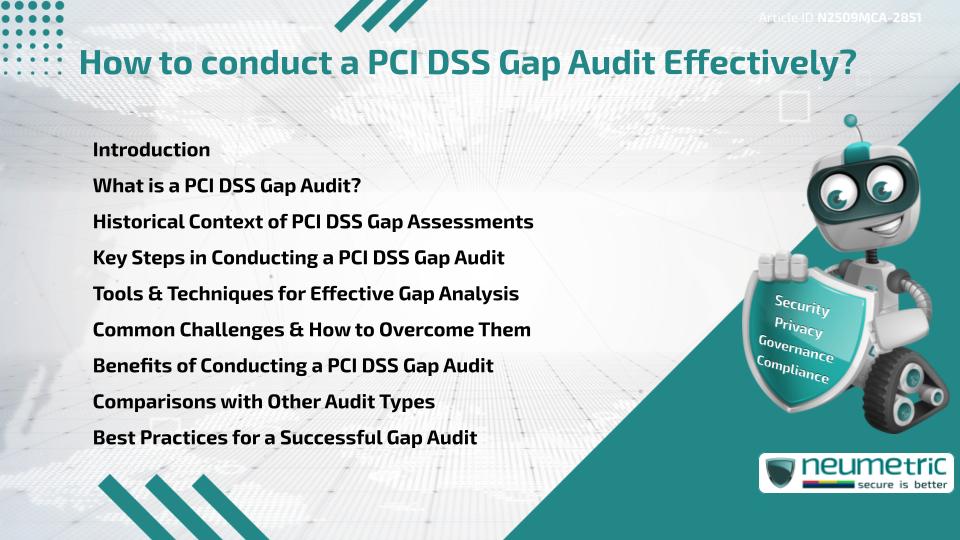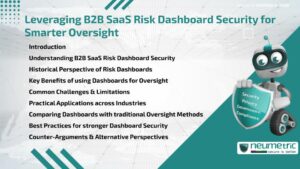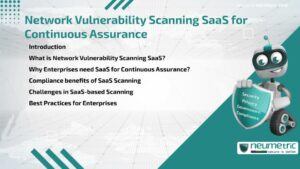Table of Contents
ToggleIntroduction
A PCI DSS Gap Audit is an essential exercise for businesses that handle credit card data. It identifies weaknesses in current security practices & prepares Organisations for official Compliance assessments. By highlighting deficiencies before Auditors arrive, a Gap Audit saves time, reduces Risks & ensures smoother Certification. This article explains what a PCI DSS Gap Audit is, its history, core steps, challenges, benefits & Best Practices for effective execution.
What is a PCI DSS Gap Audit?
A PCI DSS Gap Audit is a preliminary review of an organisation’s systems, Policies & Processes against the Payment Card Industry Data Security Standard [PCI DSS]. It acts as a rehearsal before the formal Compliance Audit. The goal is to highlight areas of Non-compliance, identify Risks & provide a clear Roadmap for Remediation. In simple terms, it is like a practice test that helps businesses prepare for the real exam.
Historical Context of PCI DSS Gap Assessments
The concept of PCI DSS Gap Audits emerged alongside the PCI DSS Framework in 2004. As businesses struggled with Compliance, Auditors & Consultants introduced Gap Assessments to help Organisations address issues early. Over time, these Audits became a Standard preparatory step, especially for companies handling large transaction volumes or sensitive payment environments.
Key Steps in Conducting a PCI DSS Gap Audit
Conducting a PCI DSS Gap Audit involves several important steps:
- Scoping: Determine which systems, processes & teams are in scope.
- Document Review: Evaluate existing Policies, Network diagrams & Security Controls.
- Testing: Perform Technical Assessments such as Vulnerability scans.
- Interviews: Engage with staff to understand day-to-day processes.
- Analysis: Compare Findings against PCI DSS requirements.
- Reporting: Create a detailed report outlining Gaps, Risks & Recommendations.
These steps provide a structured path to uncover deficiencies & plan for remediation.
Tools & Techniques for Effective Gap Analysis
Effective PCI DSS gap audits often rely on specialised tools & techniques. Automated Vulnerability scanners, Configuration Review tools & Compliance checklists streamline the process. Some businesses also engage Qualified Security Assessors [QSAs] for expert guidance. Techniques such as Sampling, Risk prioritisation & Control testing ensure the Audit is thorough & accurate.
Common Challenges & How to Overcome Them
Businesses face several challenges during PCI DSS gap audits:
- Complex IT environments: Multiple systems & Vendors can complicate scoping.
- Limited resources: Small Businesses may lack budget or expertise.
- Resistance from staff: Employees may view Audits as disruptions.
- Evolving Standards: PCI DSS updates require ongoing adjustments.
Overcoming these challenges requires planning, training & communication. Outsourcing parts of the Audit or using Third Party tools can also ease the burden.
Benefits of Conducting a PCI DSS Gap Audit
Conducting a PCI DSS Gap Audit offers many benefits:
- Early detection of Compliance issues
- Reduced Risk of Audit failure
- Lower costs through proactive Remediation
- Strengthened Security Posture
- Improved confidence during official Audits
These advantages make gap audits a vital step in any Compliance program.
Comparisons with Other Audit Types
Unlike internal audits or external penetration tests, a PCI DSS Gap Audit is specifically focused on PCI DSS requirements. While Internal Audits cover broader Governance & Operations & Penetration tests identify exploitable weaknesses, a PCI DSS Gap Audit narrows in on Compliance readiness. Together, these Audit types complement each other for a stronger overall security strategy.
Best Practices for a Successful Gap Audit
To conduct a PCI DSS Gap Audit effectively, businesses should:
- Clearly define scope & responsibilities
- Use checklists aligned with PCI DSS requirements
- Engage Stakeholders early to ensure cooperation
- Document findings & action plans thoroughly
- Revisit Gap Audits regularly, not just before Certification
Conclusion
A PCI DSS Gap Audit is a proactive measure that strengthens Compliance & Security. By identifying weaknesses before official assessments, businesses can save time, reduce costs & enhance Customer Trust. With structured steps, the right tools & a focus on Best Practices, Organisations can conduct Gap Audits effectively & prepare for smooth PCI DSS Certification.
Takeaways
- A PCI DSS Gap Audit highlights Compliance Gaps before formal Assessments.
- Key steps include scoping, document review, testing & reporting.
- Challenges include resource constraints & complex systems.
- Benefits range from cost savings to stronger Data Protection.
- Regular Gap Audits ensure long-term Compliance readiness.
FAQ
What is the main purpose of a PCI DSS Gap Audit?
The main purpose is to identify Compliance Gaps before undergoing the official PCI DSS Audit.
Who should perform a PCI DSS Gap Audit?
Gap audits can be performed by Internal Teams, External Consultants or Qualified Security Assessors.
How often should businesses conduct a PCI DSS Gap Audit?
Ideally, businesses should conduct them annually or whenever significant system changes occur.
Is a PCI DSS Gap Audit mandatory?
No, it is not mandatory but highly recommended as preparation for Compliance Audits.
How long does a PCI DSS Gap Audit take?
The duration depends on scope, but most Audits take a few days to several weeks.
What happens after a PCI DSS Gap Audit?
Businesses receive a report outlining Gaps, Risks & recommended Remediation steps.
Can Small Businesses benefit from a PCI DSS Gap Audit?
Yes, Small Businesses gain valuable insights & avoid costly Compliance failures by conducting Gap Audits.
Need help for Security, Privacy, Governance & VAPT?
Neumetric provides organisations the necessary help to achieve their Cybersecurity, Compliance, Governance, Privacy, Certifications & Pentesting needs.
Organisations & Businesses, specifically those which provide SaaS & AI Solutions in the Fintech, BFSI & other regulated sectors, usually need a Cybersecurity Partner for meeting & maintaining the ongoing Security & Privacy needs & requirements of their Enterprise Clients & Privacy conscious Customers.
SOC 2, ISO 27001, ISO 42001, NIST, HIPAA, HECVAT, EU GDPR are some of the Frameworks that are served by Fusion – a SaaS, multimodular, multitenant, centralised, automated, Cybersecurity & Compliance Management system.
Neumetric also provides Expert Services for technical security which covers VAPT for Web Applications, APIs, iOS & Android Mobile Apps, Security Testing for AWS & other Cloud Environments & Cloud Infrastructure & other similar scopes.
Reach out to us by Email or filling out the Contact Form…





